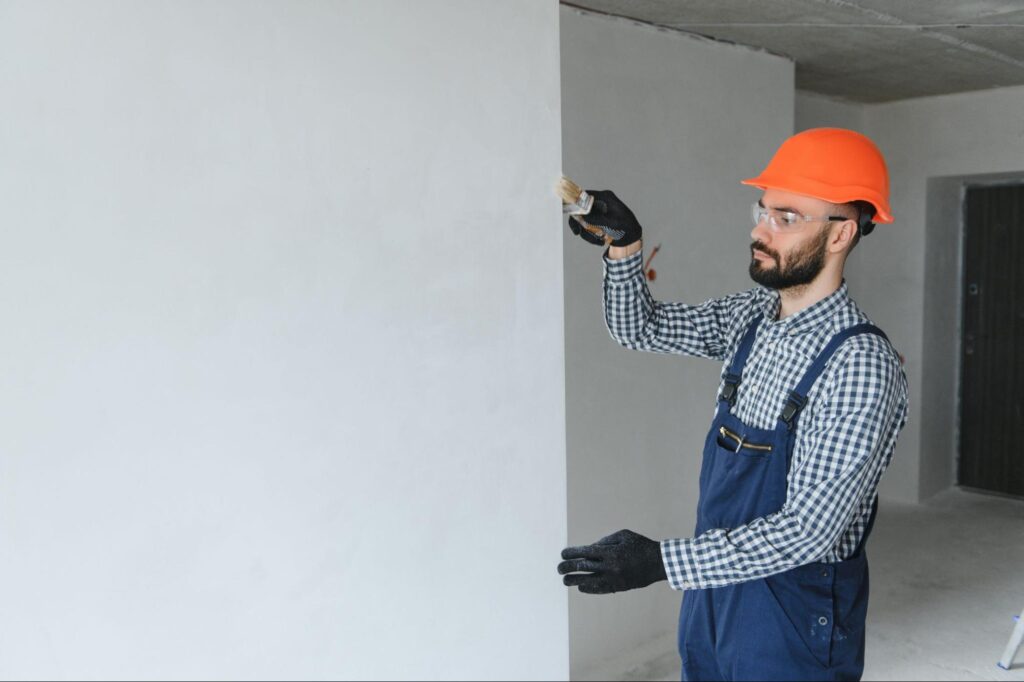
A fresh coat of paint can completely change how a home feels. It makes spaces look clean, modern, and more inviting. Many homeowners are tempted to skip hiring a pro and try painting themselves or hire someone cheap. At first glance, this is a smart way to save money. However, the real costs are not shown long after the job is done.
Why Hiring a Professional Residential Painter Matters
Hiring a professional residential painter isn’t about luxury—it’s about getting the job done right the first time. Residential painting is more than brushing color on walls. It takes precision, planning, and product knowledge. Homeowners often don’t realize how much can go wrong without that expertise.
Precision and Skill Set Make a Difference
Professional painters don’t guess their way through a job. They’ve been trained to cut in clean lines, prep walls properly, and apply paint evenly. That prep work is what keeps paint from chipping or looking blotchy. They also know how to fix surface flaws before painting begins. A DIY job often skips those steps, and it shows.
The Right Paint for the Right Surface
Every surface needs a specific type of paint. A residential painter knows which product works best on wood, drywall, or brick. Using the wrong paint can cause bubbling or cracking in just weeks. Professionals also factor in humidity, sunlight, and temperature. Those details make the difference between a quick fix and a long-term finish.
Hidden Expenses When You Skip a Residential Painter
It’s easy to underestimate how much a DIY job will cost. At first, you see savings on labor. But over time, the unexpected expenses start to pile up. Fixing mistakes, wasting materials, and losing time all add up.
The Cost of Mistakes and Redos
One of the most expensive outcomes is doing the job twice. DIY painters often miss spots, apply uneven coats, or use the wrong tools. Then, they end up hiring a professional to fix it anyway. That second round costs more than doing it right the first time, and the original effort becomes wasted time and money.
Material Waste and Overbuying
Pros know exactly how much paint and primer a job needs. They also have access to industry pricing and supplier deals. On the other hand, homeowners often overbuy or choose the wrong tools. Brushes, rollers, drop cloths, tape—it adds up fast. That extra spending eats into any savings you hoped to make.
Time Lost is Money Lost
Painting a house isn’t a weekend task for most people. It takes planning, prep, and days of actual work. That time comes from your schedule—vacation, weekends, or paid time off. Professionals work faster, with better results. Wasting your time on subpar work doesn’t make sense when your time is valuable.
Risks of Skipping a Professional Residential Painter
Painting mistakes aren’t always visible right away. Some problems reveal themselves slowly, and they’re harder to fix later. Poor paint jobs can cause more than just a bad look; they can also cause safety and legal headaches.
Surface Damage That Goes Unnoticed
Before painting, pros inspect for signs of water damage, mold, or cracks. A homeowner might paint over them, hoping for the best. That means underlying problems stay hidden and get worse over time. What starts as a simple paint job could turn into costly repairs. Professionals catch those issues before they grow.
Legal and Insurance Risks
Hiring someone off the books might save money upfront. But if there’s damage or injury, you’re responsible. Insurance often won’t cover claims if a licensed pro doesn’t do the work. And when it comes time to sell, poor paintwork can hurt your appraisal. A certified painter protects you legally and financially.
Safety Hazards During the Process
Climbing ladders, sanding walls, and dealing with fumes isn’t risk-free. Professionals follow safety codes, use proper gear, and know how to avoid accidents. DIY painters often skip safety steps or work in unsafe conditions. A single fall or injury can lead to hospital bills and lost income. That risk just isn’t worth the gamble.

Save Long-Term With a Residential Painter’s Lasting Finish
Excellent painting isn’t just about color—it’s about how it looks in detail. Clean lines, even coverage, and a polished finish don’t happen by accident. A residential painter creates results that last and look professional.
Clean Lines, Even Coats, Professional Finish
When a pro paints your home, the results speak for themselves. Edges are sharp, surfaces are smooth, and the finish is flawless. Amateur jobs often show roller marks, streaks, or uneven color. That can make even a clean home look messy. Presentation matters, especially if you’re renting or selling soon.
Paint Jobs That Last Years, Not Months
Cheap paint and poor prep lead to peeling and fading. A professional residential painter uses quality products and knows how to apply them correctly. They take steps to seal, prime, and prep that will stretch the paint job’s life. That means fewer touch-ups and less repainting over time. It’s not just about how it looks now but how it holds up.
The True Value of a Professional Residential Painter
Some homeowners hesitate to spend on a painter because the results aren’t instant savings. But the return shows up in fewer repairs, longer-lasting paint, and less stress. You protect more than your walls—you protect your peace of mind.
Protects Your Investment
Paint shields your home from moisture, sun, and wear. It preserves wood, prevents rot, and keeps surfaces healthy. Skipping steps or using poor paint leads to hidden damage. That damage becomes expensive repairs down the line. A residential painter helps you avoid that spiral.
Stress-Free Experience and Guaranteed Results
DIY jobs come with trial and error, second guesses, and delays. Hiring a pro removes that weight from your shoulders. You don’t have to learn techniques or troubleshoot mistakes. Professionals deliver results backed by warranties and timelines. That confidence alone is worth the price.

How a Residential Painter Cuts Costs During Renovations
Home renovations get messy fast, and budgets slip just as quickly. Skipping a residential painter during this time only adds more stress and delays. A skilled pro keeps your timeline steady and your costs from spiraling.
Coordination With Other Trades Prevents Delays
Professional painters don’t just show up and guess when to start. They coordinate with contractors, flooring crews, and electricians. That timing keeps your renovation moving, not stalled. DIY jobs or cheap hires often work out of sync and cause delays. Every day, your project runs over and costs you more.
Corrects Visual Imbalances from Structural Changes
Renovations leave mismatched walls, patched sections, or uneven surfaces. A pro knows how to blend colors and textures for a seamless finish. DIYers usually make these flaws more noticeable, not less. A trained painter creates balance across new and old surfaces, making your renovation look intentional, not pieced together.
Avoids Redundant Work and Material Waste
When painting isn’t done right, it has to be redone, which wastes paint, time, and money. Professionals get it right the first time using efficient techniques and exact coverage estimates. They also avoid painting areas that might be altered again later. That level of planning reduces waste and prevents do-overs.
What Residential Painters Notice That You Don’t
Professionals walk into a space and see things most homeowners miss. Their eye for detail can catch issues before they become problems, saving time, money, and hassle.
Subtle Signs of Moisture or Structural Problems
Minor stains, bubbling paint, or hairline cracks can mean deeper trouble. A residential painter will notice these and flag them before painting begins. Covering them up makes things worse later. Addressing these early on can prevent structural damage or mold. That awareness is part of what you’re paying for.
Inconsistent Lighting and Color Reflection
Natural and artificial light changes how paint looks from room to room. Professionals test samples under different lighting conditions before committing. Homeowners often skip this step and regret the final color. What looks beige in-store may look yellow at home. Painters know how to make color decisions that hold up in real life.
Common DIY Painting Myths That Cost You More
Plenty of advice online makes DIY painting sound simple. The problem is, a lot of that advice doesn’t hold up. Believing the wrong things can make you spend more in the end.
“Two Coats Always Do the Job”
Some paints cover better than others, but two coats aren’t a magic number. Depending on the surface, condition, and color, you may need more or less paint. Professionals assess each situation and plan accordingly. Guessing leads to thin coverage or wasted product. Trust experience, not blanket rules.
“Primer is Optional if You Use Quality Paint”
Skipping primer is one of the most expensive shortcuts. Without it, paint won’t stick or last on certain surfaces. Professionals know when and where the primer is non-negotiable. It’s not about the label on the can—it’s about what the wall needs. Primer isn’t optional when you want long-term results.
Trust a Residential Painter, Not Just a Paint Can
The walls in your home don’t just hold up the roof—they hold up your life. Every scuff, crack, and brushstroke tells a story about how much you care for your living space. When you skip a professional residential painter, you don’t just cut costs—you cut corners on quality, protection, and peace of mind. Painting may seem like a small decision, but it ripples through your home’s value, comfort, and longevity. Spend once, do it right, and walk into a room that reminds you every day that you made the smarter choice.
Before you pick up that paintbrush, see what the pros know. The Euro Painting blog has your back.

